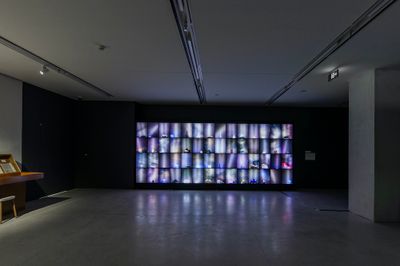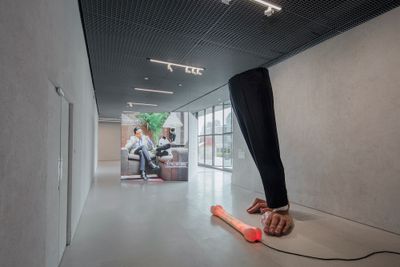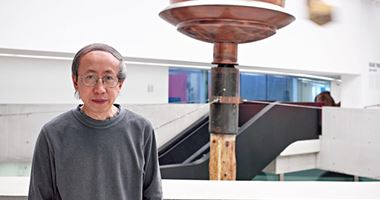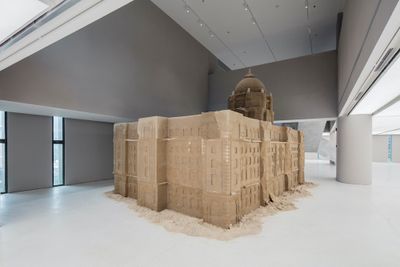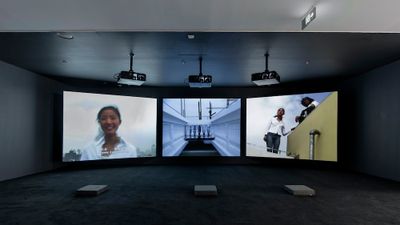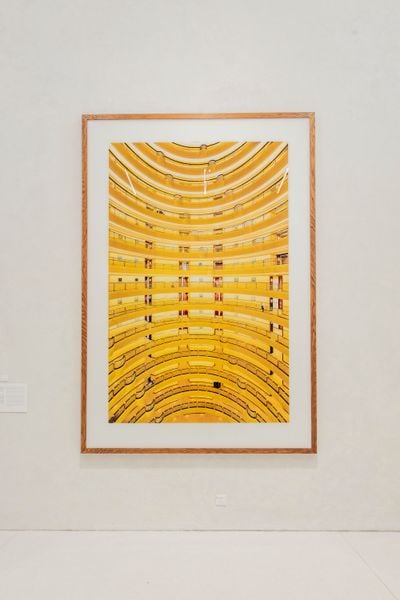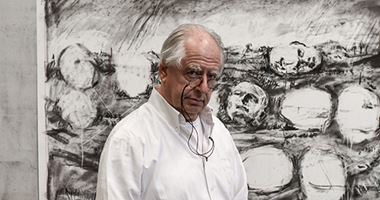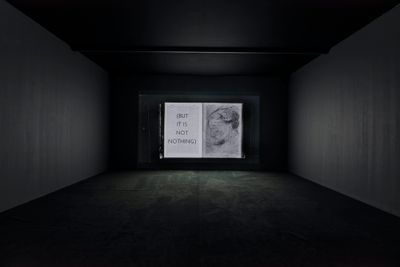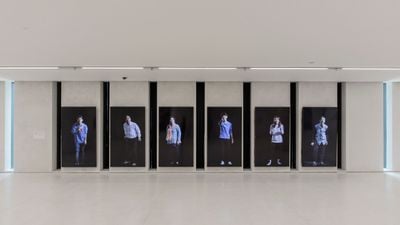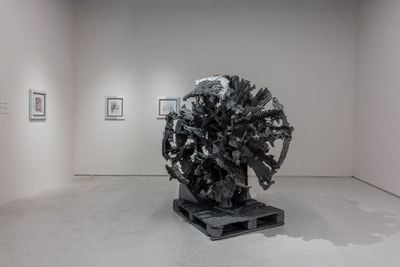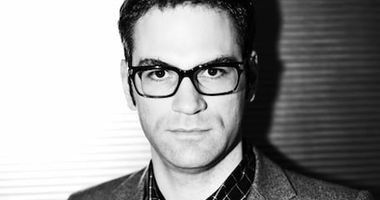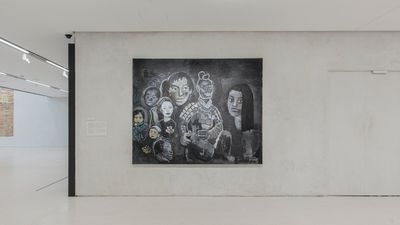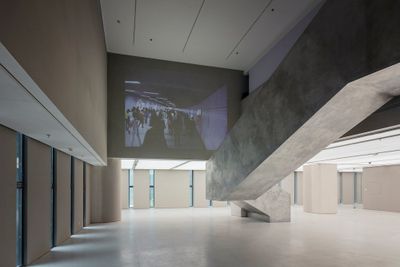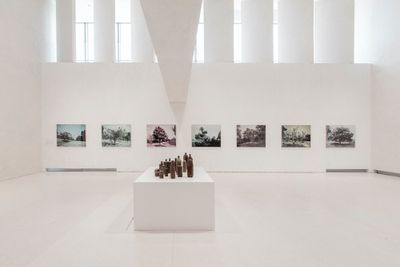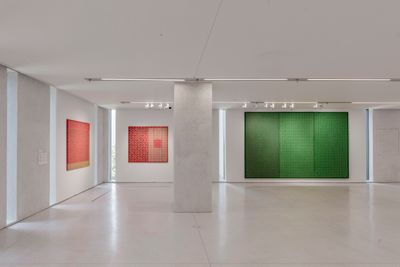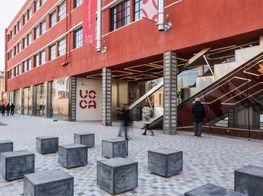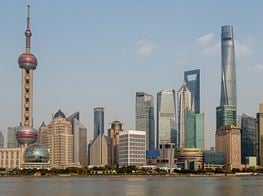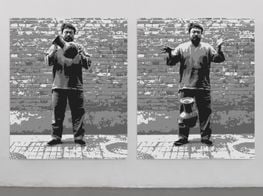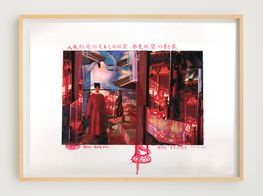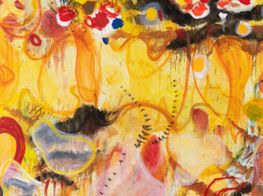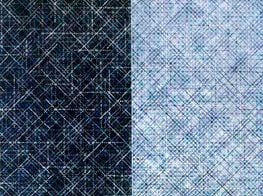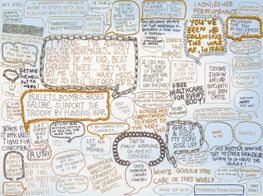UCCA Edge Launches in Shanghai with Homage to 2000
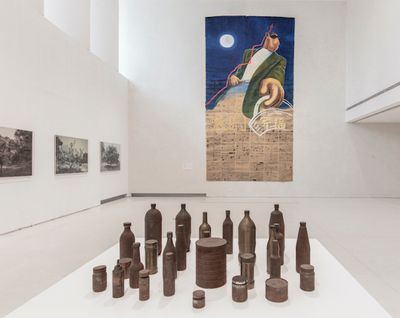
Exhibition view: City on the Edge: Art and Shanghai at the Turn of the Millennium, UCCA Edge, Shanghai (22 May–11 July 2021). Courtesy UCCA Center for Contemporary Art.
Since Beijing-based UCCA Center for Contemporary Art announced a new satellite museum in 2019, the opening of UCCA Edge in Shanghai has been hotly anticipated.
Positioned as a 'stylish hub for urban elites,'1 the name refers to the museum's location by Suzhou Creek, which coincidentally marks the historic boundary of the city's International Settlement and the surrounding Chinese controlled areas. It also suggests the peripherality of the new museum in relation to Beijing's centrality.
UCCA Edge is the third branch after the museum's original location in Beijing's 798 Art District and a sister-site on the beach in Beidaihe, and strikes quite the contrast to its predecessors, taking up three floors of a newly built office tower designed by Brooklyn architects, SO – IL.
Arguably, it isn't entirely easy to like: a big, New York-style statement building in the form of a glassy stack of boxes. The overwhelming impression as one ascends the long, illuminated escalator is of a high-end retail experience. Alighting the foyer, this sense is reinforced: low white ceilings; flat LED lighting; large, low-contrast floor tiles; muted white walls interrupted by narrow views to the outside—the feeling is, well, pharmaceutical.
With only 1,700 square metres of display area, most with the kind of low ceilings more appropriate to an office plan, how space dictates form is already evident in the inaugural exhibition, City on the Edge: Art and Shanghai at the Turn of the Millennium (22 May–11 July 2021).
The show begins with Huang Yong Ping's Bank of Sand, Sand of Bank (2000), a large disintegrating sand sculpture of the 1923 HSBC headquarters on the Bund, boxed in awkwardly in the lobby. While this placement at the entrance to an exhibition in which the 3rd Shanghai Biennale in 2000 is a significant curatorial touchstone makes sense—Huang's is the only work from that exhibition to feature—this is also the only location it seems to physically fit.
As a whole, City on the Edge locates itself at a critical juncture in the development of China's art ecology, specifically with the 3rd Shanghai Biennale in 2000 and the wave of new institutions, events, and peripheral exhibitions that emerged around that time. None more significant than Fuck Off (known in Chinese as 不合作方式 , 'An Uncooperative Approach'), the now apocryphal satellite exhibition curated by Feng Boyi and Ai Weiwei.
In Fuck Off, a then-unknown Yang Fudong presented 'The First intellectual' (2000), a photographic series that was quickly removed by the Cultural Bureau as 'pornographic', in part because one image featured a young man in a torn suit standing in front of the then-new Jinmao Tower, covered in blood and brandishing a brick. The juxtaposition of the symbol of state-sanctioned capitalism with violence proved too much.
Here, Yang presents Flutter, Flutter... Jasmine Jasmine (2002), a three-channel video that offers a vision of young lovers illustrating the words of a romantic song while looking headlong into the future against the backdrop of Shanghai. Yang's less-than-promising vision of Jinmao Tower is replaced by Andreas Gursky's staged photograph of the building's interior, a paean to its glittering opulence (Shanghai, 2000).
The exhibition can sometimes make tenuous connections, suggesting that Gursky's image is melancholy—no longer the tallest structure in Pudong, it is 'merely existing within a larger neighbourhood'—which it is not. But it does provide an opportunity to include Gursky, one of the international artists to have appeared in the 2000 Shanghai Biennale, in this show.
Other international artists connected to this edition include William Kentridge, who is showing a new animation, Sibyl (2021), based on the libretto for his chamber opera Waiting for the Sibyl (2019). Alluding to the myth of the Cumean Sybil, a prophetess who would write one's fortune on the swirling oak leaves littering her cave floor, the film is a melodic meditation on unknowable futures.
Matthew Barney, who debuted in the 2000 Shanghai Biennale with Cremaster 4 (1994), the first in the acclaimed 'Cremaster Cycle', is represented with one of his recent water-cast sculptures from the series 'Khepera' (2016/2021), surrounded by a suite of electro-formed copper etchings, related to the films River of Fundament (2014) and Redoubt (2019).
...the excitement and boisterous bottom-up activity that emerged in the period that City on the Edge draws from quickly gave way to sanctioned spaces and culture parks: 'formalized area[s] with a visible, almost aggressive, branding strategy.'
The decision to present new works by these artists rather than those first seen in 2000 is puzzling, though both Kentridge and Barney have been the subjects of solo exhibitions with UCCA Beijing in 2015 and 2019 respectively, which may explain their inclusion over other major international artists who appeared in the 2000 event.
Among the looser Biennale connections is Yan Lei's 'The Fifth System' (2004), a series of beautiful monochrome paintings of seemingly innocuous nature scenes, however the detail of a low wall in the background provides further context.
In 2003, Yan participated in the exhibition The Fifth System: Public Art in the Age of Post-Planning at Shenzhen Art Museum. His work, a response to the hyperdrive development of Shenzhen since its designation as a Special Economic Zone, involved convincing local authorities to wall off a plot of land the size of a football field in the most expensive district for the two-year duration of the exhibition, naturally bringing him into conflict with developers. While the parallels with development in Shanghai are clear, the real connection is more prosaic—Hou Hanru, curator of the 3rd Shanghai Biennale, curated The Fifth System.
Apart from the Biennale serving as a key reference to bind the assembled works together, City on the Edge can feel like little more than a collection of works related to the period or the city—a collection of old friends. This would be fine, given director and curator Philip Tinari described the curatorial intent elsewhere as a 'love letter to millennial Shanghai.'2 Yet the central thesis feels unnecessarily overburdened.
Architect and author Ying Zhou posited that the 3rd Shanghai Biennale represented 'the state's appropriation of contemporary art as an alibi for demonstrating its open-mindedness,'3 and that Fuck Off was essentially reactionary. If so, then City on the Edge resonates more with the former.
Still, some inclusions, such as Zhou Tiehai's Buy Happiness/ You Can't Grow Healthy and Strong Without the Godfather's Protection (1997), Yu Youhan's Black Painting (2000), and a suite of paintings by Zhang Enli and Ding Yi fit so perfectly that they begin to feel like fan servicing. Zhang Enli's expressive 'Hair' portraits (2001/2002) are particular delights.
Xu Zhen, one of the youngest artists to participate in Fuck Off, also featured in Biennale satellite exhibitions, Useful Life (2000) and the Fan Mingzhen & Fan Mingzhu – Glad to Meet You (2002). The two works inject some much-needed elan into this 2021 tribute. Shouting (1998/2021) is filmed from the point of view of an anonymous actor who appears in various public spaces and unleashes a primal scream, usually to the brief shock and amusement of passersby. Provocative and childishly amusing, it is a simple act of assertion—a common theme throughout Xu's work.
Recreated for UCCA Beijing in 2014, March 6 (2002/2021), which was in Fan Mingzhen & Fan Mingzhu – Glad to Meet You sees dozens of performers, dressed in pyjamas similar to those worn by psychiatric patients, selecting members of the public to follow around the gallery. They do not make eye contact and they remain at a distance, shadowing each visitor until they leave.
Xu Zhen's intervention upends the usual conditions of gallery-going in a way that is at once vaguely aggressive and absurd. But this current epoch of mask wearing and social distancing adds an altogether different layer of meaning: the public sphere is no longer as it once was. Shared spaces harbour unacknowledged menace.
Continuing the theme of rapid change are five photographs from Canadian photographer Greg Girard's 'Phantom Shanghai' series (2001–2007), which record the last houses left within demolished blocks in the city. Eerily lit, they are haunting and familiar—such places still exist. Breathtaking as they are, though, it is hard not to think of a number of local photographers who meet the terms of reference for the exhibition and are nonetheless unrepresented.
Even before it arrived, the 2000 Shanghai Biennale was cast as historic: the first state-organised exhibition of contemporary art to invite international artists and curators, dealing with a broad range of social issues such as globalisation and post-colonialism. As the Biennale's artistic committee director Fang Zengxian, wrote: 'The significance of [the Biennale's] success will far transcend the exhibition itself.'4
However, as art historian Wu Hung pointed out on the event, 'Practical matters . . . dominated the discussions; the exhibition's content and contribution to art itself attracted much less attention.'5 Likewise, while UCCA Edge clearly intends to position itself as a descendant of this landmark moment in contemporary Chinese art, similarly divergent positions could be carved out for the meaning and magnitude of its arrival.
As commentators like Ying Zhou have argued, the excitement and boisterous bottom-up activity that emerged in the period that City on the Edge draws from quickly gave way to sanctioned spaces and culture parks: 'formalized area[s] with a visible, almost aggressive, branding strategy.'6 Alternative activities succumbed to the state, becoming commercialised and gentrified to ensure their survival. It is difficult not to view UCCA Edge within the context of this process. —[O]
1 UCCA Edge marketing, http://www.edge-sh.com/en/overview.html
2 Oliver Giles, 'How UCCA Center For Contemporary Art's Expansion Project Is Bringing New Life To Shanghai's Art Scene', Tatler, 4 January 2021, https://hk.asiatatler.com/life/ucca-center-for-contemporary-art-shanghai
3 Ying Zhou, Growing Ecologies of Contemporary Art: Vignettes from Shanghai, (University of California Press: 2015).
4 Preface, Shanghai Biennale 2000, exhibition catalogue (Shanghai Art Publishing House, Shanghai: 2000).
5 Wu Hung, 'The Shanghai Biennale 2000: The Making of a Historical Event in Chinese Contemporary Art', Making History: Wu Hung on Contemporary Art, (Timezone 8, Beijing: 2008).
6 Ibid.

